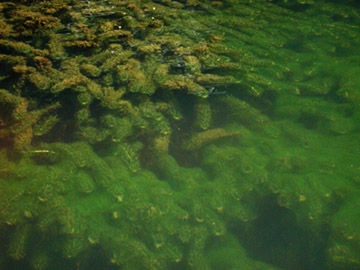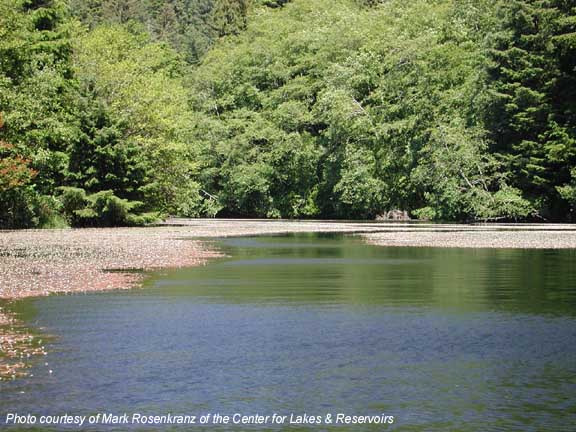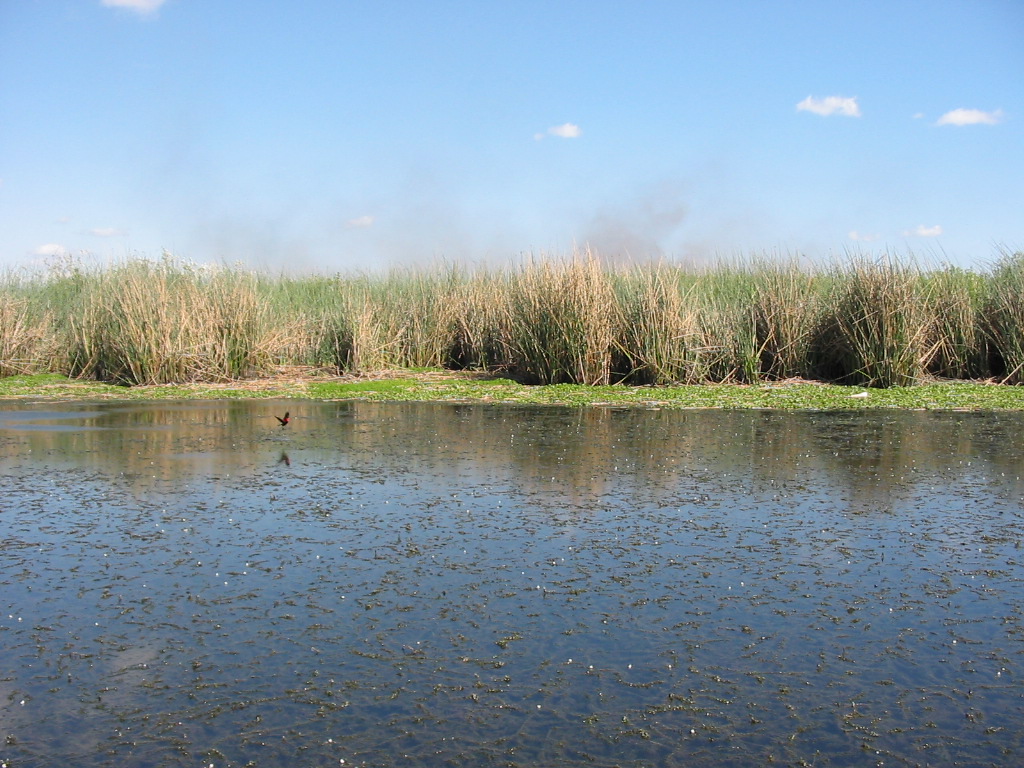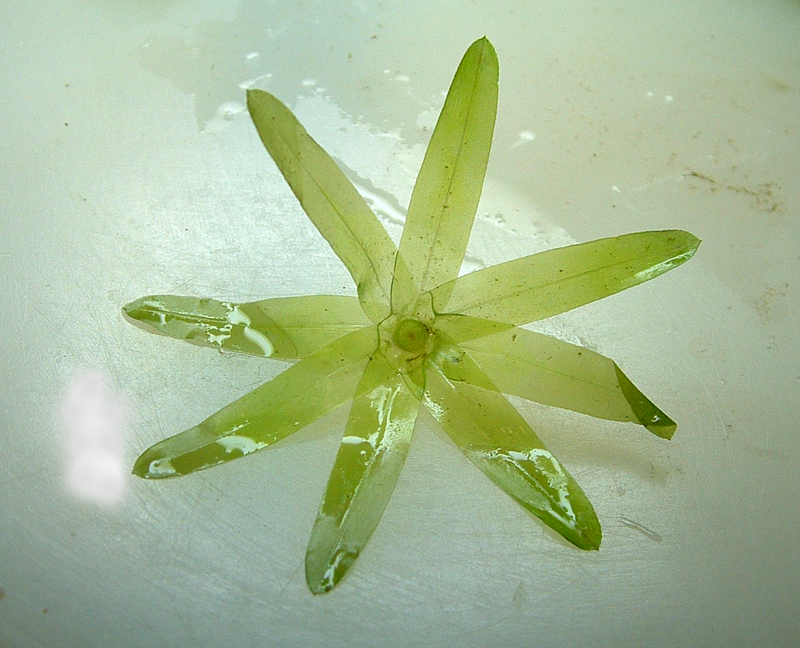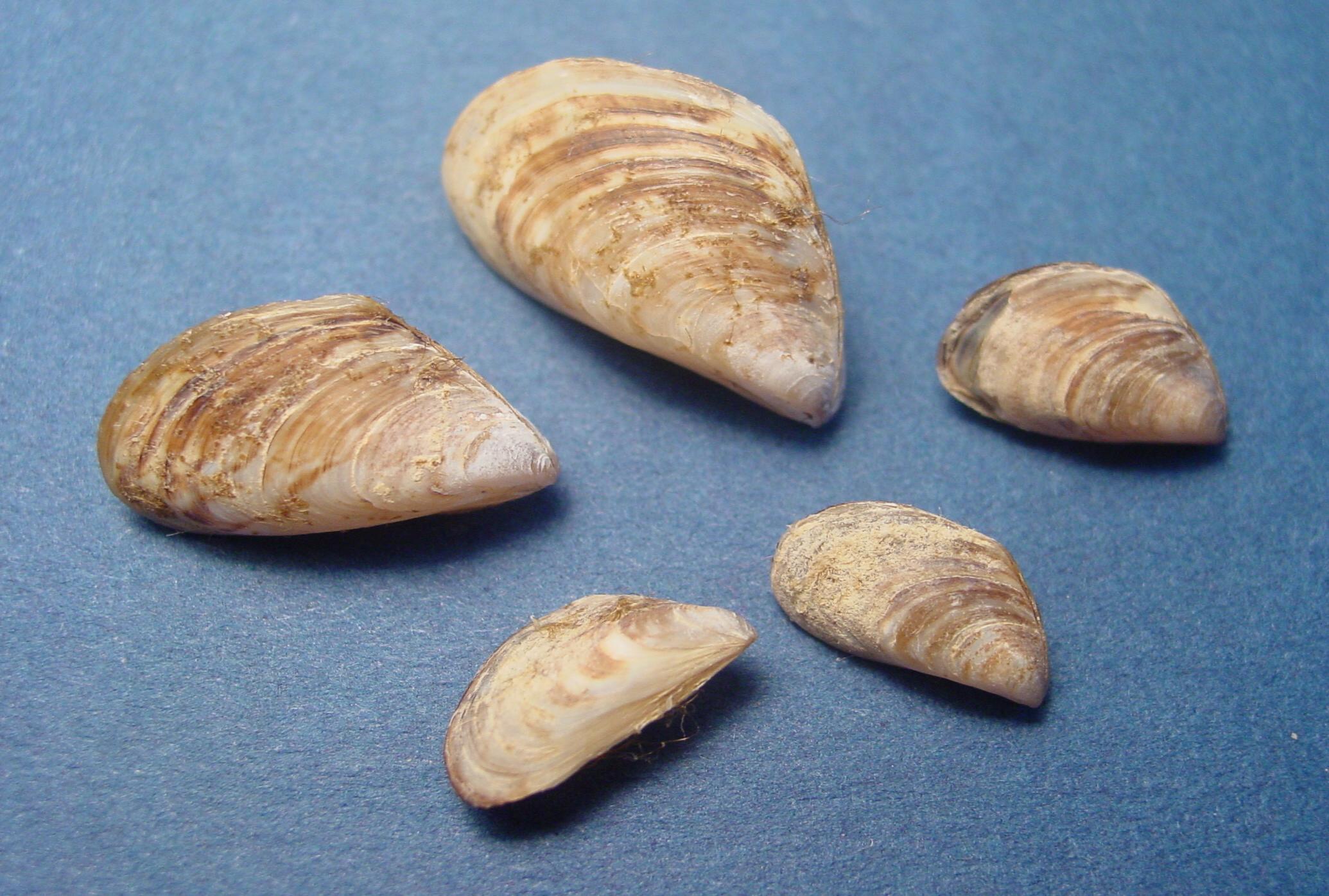|
Quick Links
Egeria densa ProjectContact InformationToni Pennington Portland State University Introduction
E. densa in the Western USIn Oregon , the plant has infested over 10,000 acres of lakes and reservoirs, including coastal lakes that are critical habitat for Coho salmon, and is common in Willamette reservoirs and Columbia River side channels. It is responsible for the listing of over 60 percent of the Oregon lakes currently considered "water quality limited" under the Clean Water Act. E. densa causes over $3.5 million per year in economic losses in Oregon through recreational impacts alone (Oregon Department of Agriculture 2001); however, ecological impacts have not been quantified.
The Washington Department of Ecology identified 18 lakes in Western Washington infested by E. densa which is considered a Class B noxious weed in King County. In Long Lake, Washington, E. densa comprised approximately 90% of the aquatic vegetation and persisted despite of 19 years of management that included a drawdown and harvesting (Jacoby et al. 2001). In California E. densa covers about 3,900 acres in the Sacramento-San Joaquin Delta, is spreading at about 100 acres/year, and has been the subject of an intensive chemical control program (California Department of Boating and Waterways 2000) that has spawned lawsuits aimed at reducing or eliminating the use of herbicides. Stands of E. densa in the Delta support more introduced fishes than native (Grimaldo et al. 2000) and provide habitat for another NIS, the Chinese mitten crab (Eriocheir sinensis).
Lack of sexual reproduction has resulted in an extremely homogenous E. densa genotype in the Pacific Northwest . Carter and Sytsma (2001) found that E. densa collected throughout western Oregon was essentially one genotype. Remarkably, a limited number of samples from Chile exhibited the same genotype as the Oregon population. In Brazil , E. densa (as well as E. najas, Ceratophyllum demersum , and Eichhornia crassipes ) have severely infested hydropower reservoirs. It was estimated that 48,000 m 3 of aquatic weeds were removed from water intake structures in Jupia Reservoir (Marcondes et al. 2000). E. densa BiologyE. densa is a dioecious, submersed perennial found in lentic and lotic freshwater systems. Only male plants are found in the U.S. and, even in its native range, male plants outnumber female plants by as much as 6:1 (Cook and Urmi-König 1984). Since only males are present outside the indigenous region, dispersal and perennation of E. densa is only by vegetative fragmentation. It branches along the stem in areas referred to as "double nodes" (Jacobs 1946). These double node regions are important in carbohydrate storage and vegetative reproduction of lateral buds, adventitious roots, and root crowns (Getsinger 1982). Double nodes occur every 10 -12 internodes. Thus, the frequency of double nodes is important in plant architecture, canopy formation, biomass production, and overwintering success.
Identification of "weak points" in the lifecycle of a plant permits development of optimally effective management by keying management to plant biology. For example, management of Eichhornia crassipes (Luu and Getsinger 1990) and Hydrilla verticillata (Madsen and Owens 1998) has been enhanced by targeting management to periods when carbohydrate reserves and the ability of the plant to recover from the management are lowest. This method was, however, less successful in improving control of Myriophyllum spicatum in a Washington lake (Perkins and Sytsma 1987). E. densa research in OregonAn assessment of seasonal carbohydrate allocation patterns and morphological changes in E. densa was conducted from 2001 to 2003. Plants were sampled from Big Creek Reservoir near Newport , Oregon along the North central coast. Plants were sampled monthly and separated into tips, upper and lower stems, root crowns and roots and analyzed for total nonstructural carbohydrates, carbon and nitrogen. Changes in double node allocation, important in canopy formation, were also examined. This project was supported by the Washington Department of Ecology and the Aquatic Ecosystem Restoration Foundation. E. densa research in CaliforniaSeasonal changes in nutrient allocation were also measured in an E. densa population growing in the Sacramento-San Joaquin Delta in California . Again, plants were sampled monthly, separated and similarly analyzed. Additionally, plant production under varying light levels was assessed to determined seasonal maximum photosynthetic rates, photosynthetic efficiency and light saturation levels under field conditions. Plants were tagged in situ to measure changes in stem and tip growth in fall, winter, spring and summer. Viability of stem fragments collected seasonally are currently being evaluated under controlled greenhouse conditions. SlideshowProduction and growth rates of Egeria densa in the Sacramento-San Joaquin Delta, CA. (APMS 2005) by T. Pennington (MSPowerpoint .pps file) ReferencesCalifornia Department of Boating and Waterways. 2000. Draft Environmental Impact Report for the E. densa Control Program. Carter, M. C. and M. D. S. (2001). Comparison of the genetic structure of North and South American populations of a clonal aquatic plant. Biol. Invasions 3: 113-118. Coffey, B.T. and J.S. Clayton. 1986. Submerged macrophytes of Lake Pupuke , Takapuna , New Zealand . New Zealand Journal of Marine and Freshwater Research 21: 193-198. Cook, C.D.K. and K. Urmi-König. 1984. A revision of the genus E. densa (Hydrocharitaceae). Aquatic Botany 19: 73-96. Getsinger, K.D. 1982. The Life Cycle and Physiology of the Submersed Angiosperm E. densa Planch. in Lake Marion , South Carolina . Ph.D. dissertation. Clemson University . 104 pp. Grimaldo, L., R. Miller, C. Peregrin, Z. Hymanson, and J. Toft. 2000. How does Brazilian waterweed ( Egeria densa ) influence the fish assemblage in the Sacramento-San Joaquin Delta (CA)?: Potential conflicts with ecosystem restoration. Abstract from the 2000 Missouri Chapter of the American Fisheries Society, St. Louis , MO. Haramoto, T. and I. Ikusima. 1988. Life cycle of E. densa Planch., an aquatic plant naturalized in Japan . Aquatic Botany 30: 389-403. Jacobs, D.L. 1946. Shoot segmentation in Anacharis densa . American Midland Naturalist 35: 283-286. Jacoby, J.M., E. B. Welch, and I. Wertz. 2001. Alternate stable states in a shallow lake dominated by Egeria densa . Verh. Internat. Verein. Limnol. 27: 3805-3810. Luu, K.T. and K.D. Getsinger. 1990. Seasonal biomass and carbohydrate allocation in waterhyacinth. Journal of Aquatic Plant Management 28: 3-10. Madsen, J. and C.S. Owens. 1998. Seasonal biomass and carbohydrate allocation in dioecious hydrilla. Journal of Aquatic Plant Management 36: 138-145. Marcondes, D. A. S., A. L. Mustafa, R. H. Tanaka, D. Martins, E. D. Velini, and R. A. Pitelli. 2000. Studies for aquatic plant management in hydro electrical lakes in Brazil . Abstract. Annual Meeting of the Aquatic Plant Management Society. San Diego , CA . Oregon Department of Agriculture. 2001. Economic Analysis of Containment Programs, Damages, and Production Losses From Noxious Weeds in Oregon . Noxious Weed Control Program, Plant Division. Salem , OR . 58 pp. Perkins, M.A. and M.D. Sytsma. 1987. Harvesting and carbohydrate accumulation in Eurasian watermilfoil. Journal of Aquatic Plant Management 25: 57-62. Roberts, D.E., A.G. Church, and S.P. Cummins. 1999. Invasion of E. densa into the Hawkesbury-Nepean River, Australia. Journal of Aquatic Plant Management 37: 31-34. For additional information, see the following links:Invasivespecies.gov The Washington Department of Ecology Center for Aquatic and Invasive Plants The Western Aquatic Plant Management Society |
|

 E. densa Planchon (Hydrocharitaceae), which is native to Brazil and Argentina (Cook and Urmi-König 1984), has invaded New Zealand (Coffey and Clayton 1986), Japan (Haramoto and Ikusima 1988), Chile (Cook and Urmi-König 1984) and Australia (Roberts et al. 1999). In the US, E. densa has invaded lakes and ponds from Washington to California , across the South, and as far North as Vermont and New Hampshire on the East Coast (Cook and Urmi-König 1984).
E. densa Planchon (Hydrocharitaceae), which is native to Brazil and Argentina (Cook and Urmi-König 1984), has invaded New Zealand (Coffey and Clayton 1986), Japan (Haramoto and Ikusima 1988), Chile (Cook and Urmi-König 1984) and Australia (Roberts et al. 1999). In the US, E. densa has invaded lakes and ponds from Washington to California , across the South, and as far North as Vermont and New Hampshire on the East Coast (Cook and Urmi-König 1984).